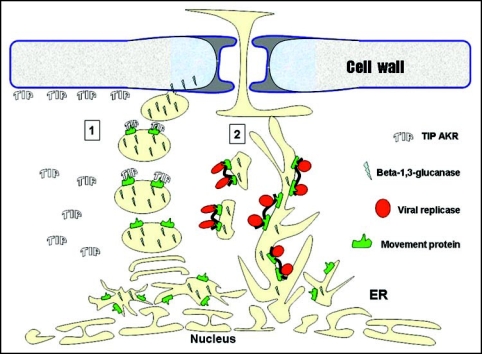Figure 1.
Hypothesized model for viral Pd targeting and callose hydrolysis in tobacco. Early in infection, viral RNA replicates in association with ER membranes through viral replicase. Viral replication induces a PR reaction resulting in callose accumulation around Pd. Viral RNA synthesizes MP which incorporates as a intrinsic membrane protein into ER and ER derived vesicle bodies, both of which also contain β-1,3-glucanase (e.g., ER-derived sphrosome-like bodies ref. 12). MPs can then function in two different pathways; 1. MP binds TIPs cytoplasmic proteins which are involved in directing ER-vesicles to the cell periphery (see ref. 17) adjacent to the Pd. The vesicles, containing β-1,3-glucanase cargo, fuse to plasma membrane and deliver β-1,3-glucanase to the cell wall. Callose is hydrolyzed allowing Pd to dilate. Vesicles recycle back to the ER; 2. The ER with embedded MP binds viral RNA and replicase. Vesicles are formed and transported to the cortical ER and Pd. Vesicles fuse to cortical ER. The complex of MP with viral RNA and virus replicase diffuse in ER to adjacent cell.

